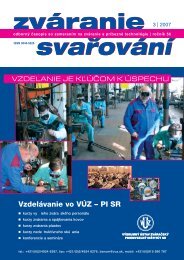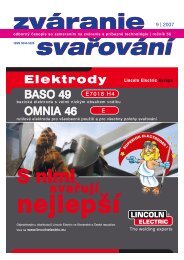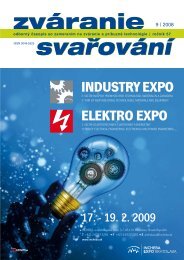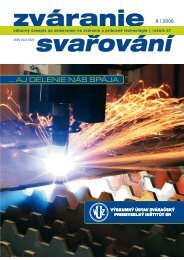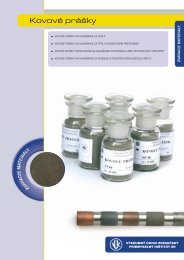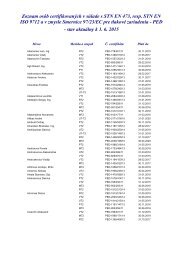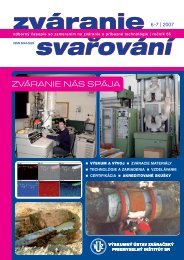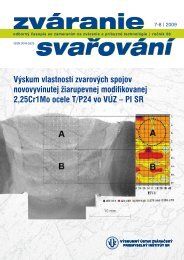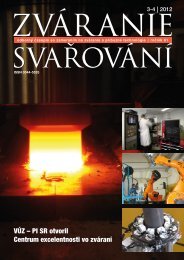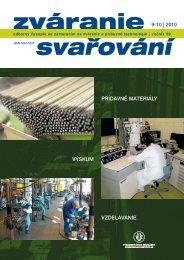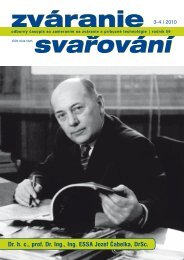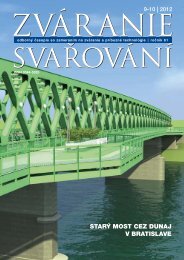Schvaľovanie postupov zvárania kovových materiálov WPQR
súlad krásy architektúry a kvality zvárania - Výskumný Ãstav zváraÄský
súlad krásy architektúry a kvality zvárania - Výskumný Ãstav zváraÄský
- No tags were found...
You also want an ePaper? Increase the reach of your titles
YUMPU automatically turns print PDFs into web optimized ePapers that Google loves.
Skúsenosti a nové možnosti <strong>zvárania</strong> duplexných nehrdzavejúcich ocelítovených hybridným laserovýmzváraním sa dosiahli vďaka potrebnémumnožstvu zvarovéhokovu z prídavného drôtu, udržaniudostatočne vysokého tepelnéhopríkonu (a teda zabráneniuochladzovania nadmernou rýchlosťou)a zabráneniu strát dusíkapoužitím ochranného plynu s podielomdusíka.CONCLUSIONSTo produce welds in duplex stainlesssteels with adequate properties it isnecessary to control the weld metalchemistry and cooling rate. Withcommon arc welding methods usingfiller material and standard recommendationsregarding heat input [4]it is usually not a major problem tofulfil welding procedure qualificationrequirements. Basically thesere commendations are designed toensure a proper ferrite to austeniteratio and that at least not significantamounts of secondary phases suchas nitrides or intermetallic phasesform in the weld metal or HAZ. Movingto lower heat input and higherdilution welding processes, e.g. laserwelding, it is important to makesure that enough austenite is formedto avoid nitride precipitation (Fig. 1)and a brittle largely ferritic weld.SMAW of superduplex pipes – thefirst of the three examples above illustrateshow secondary phases,in particular intermetallics, affectproper ties. In the case of superduplexgrades, it is sometimes difficultto avoid this precipitation completelyin multiple reheated regions. However,some intermetallics can oftenbe tolerated without unacceptabledegradation of properties. It is concludedthat a microstructural examinationcan provide useful informationabout the presence and locationof secondary phases. Qualificationof welding procedures should,how ever, mainly be based on directmeasurement of mechanical propertiesand corrosion resistance [23].It is of course nevertheless desir ableto avoid unwanted phases wheneverpossible. The potential advantagesof using SCW welding insteadof conventional SAW was shown forsuperduplex in the second example.The gains are most obvious forthicker material where productivityimprovements can be significant.Fewer beads are needed for a givenjoint thereby increasing productivi tywithout increasing heat input. It wasnoted that no signs of intermetallicprecipitation were detected in spiteof the comparatively high heat inputsused.Although it is likely that for the foreseeablefuture duplex stainlesssteels will in large part continue tobe welded using established arcprocesses there is an interest in applyingnew welding processes to increaseproductivity. It is not withoutcomplications to apply low heat inputautogenous methods such as laserwelding (Fig. 1) [24]. However, inlaser-hybrid welding addition of fillermaterial can be used to control weldmetal chemistry and cooling rate canbe limited while still increasing weldingspeed. At present laser-hybridwelding seems to be the recentlyintroduced technique most likely tobe used on a larger scale and thisis an area where there is considerablescope for future research anddevelop ment. Example three clearlyillustrates the potential of the techniqueand together with exampletwo point at possibilities to extendthe range of highly productive weldingmethods suitable for duplex steelgrades.Possibilities and potential problemsassociated with attempts at increasingproductivity in welding duplexstainless steels are discussed givingthree examples. Superduplex girth SMAW weldswere used to study how smallamounts of secondary phasescan affect properties. Corrosion resistance was not significantlyaffected by σ-phase formedin multiply reheated regions. Impacttoughness was somewhat reducedbut WPQ requirements could stillbe met. Microstructural examination canprovide useful information aboutthe presence and location ofsecond ary phases. Qualification ofwelding procedures should, however,mainly be based on directmeasurement of properties. Synergic cold wire submerged arcwelding was applied successfullyto welding of superduplex 20 mmplate material. The superduplex SCW weld displayedmechanical properties includingstrength, toughness andhardness that fulfil typical requirements.No unwanted phases weredetected and the ferrite contentwas in the range 57 FN to 70 FN. SCW offers the possibility to increaseproductivity in weldingof highly alloyed stainless steelswith maintained properties mainlysince the number of weld passesand the dilution with parent materialcan be decreased. Highly productive laser-hybridwelding was successfully appliedto welding of standard 22 % Crduplex stainless steel. Laser-hybrid welding producedwelds with a fine grain size, properphase balance and a very narrowHAZ. Impact toughness wason a high level. The excellent properties of the laser-hybridwelds was attributed tothe facts that a) filler wire can beadded, b) that heat input can bekept sufficiently high to avoid excessivecooling rates and c) thatshielding gas with nitrogen additionscan be used to prevent nitrogenlosses.Literatúra[1] Practical guidelines for the fabricationof duplex stainless steels. IMOA,London, England, 2001[2] Benson, M.: Applications utilising theadvantageous properties of LDX 2101(EN 1.4162, UNS SS2101). In: Proc.Stainless Steel World 2005,Maastricht, The Netherlands, Nov. 8 –10, 2005, s. 171 – 176[3] Karlsson, L.: Review: Intermetallicphase precipitation in duplex stainlesssteels and weld metals – metallurgy,influence on properties, welding andtesting aspects. WRC Bulletin,January 1999, Vol./č. 438, ISSN0043-2326, s. 1 – 23[4] EN 1011-2, Welding –Recommendations for welding ofmetallic materials. Part 2: Arc weldingof ferritic steels[5] Lukkari, J.: Look at deposition rates inSAW now! Svetsaren, 2001, č. 2 – 3,s. 51 – 57[6] ESAB information folder 2000, Fluxesand wires for Submerged ArcWelding, 40[7] ESAB information folder, A6 SynergicCold Wire, The ESAB A6 – SCWSAW process[8] Rigdal, S. – Karlsson, L. – Östgren L.:Synergic Cold Wire SAW of stainlesssteels. In: Proc. Stainless Steel World2001, The Hague, The Netherlands,Nov. 13 – 15, 2001, s. 32 – 36[9] Rigdal, S. – Karlsson, L. – Östgren,L.: Synergic Cold Wire (SCW)submerged arc welding – Applicationof a new cost efficient weldingtechnique to stainless steels. In: Proc.Stainless Steel World America 2002,Houston, Texas, USA, Feb. 12 – 14,2002, s. 169 – 175[10] Rigdal, S. – Karlsson, L. – Östgren,L.: Synergic Cold Wire (SCW) SAW– Application of a new cost efficientwelding technique to stainless steels.Svetsaren, 2002, č. 2, s. 26 – 31[11] Rigdal, S. – Karlsson, L. – Östgren,L.: Synergic Cold Wire (SCW)submerged arc welding of highlyalloyed stainless steels. In: Proc.Stainless Steel World 2003,Maastricht, The Netherlands, Nov. 11– 13, 2003, s. 283 – 294170 ZVÁRANIE-SVAŘOVÁNÍ | 6-7/2008



